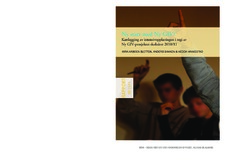| dc.contributor.author | Bakken, Anders | |
| dc.contributor.author | Sletten, Mira Aaboen | |
| dc.date.accessioned | 2020-06-07T21:05:49Z | |
| dc.date.accessioned | 2021-04-29T13:58:13Z | |
| dc.date.available | 2020-06-07T21:05:49Z | |
| dc.date.available | 2021-04-29T13:58:13Z | |
| dc.date.issued | 2011 | |
| dc.identifier.isbn | 978-82-7894-402-8 | |
| dc.identifier.issn | 0808-5013 | |
| dc.identifier.uri | https://hdl.handle.net/20.500.12199/3368 | |
| dc.description.abstract | Ny GIV is a three-year effort by the government to increase the completion rate in secondary education. This report is about the Transition Project (Overgangsprosjektet) in Ny GIV. The aim of the Transition Project is to increase students' prerequisite for the implementation of secondary education by providing the weakest performing students intensive training in basic reading, writing and arithmetic skills. The target group for intensive training is the 10 per cent with the lowest grades after the first period of tenth grade. In addition to intensive training the transition project include training and motivational activities during the summer holidays between tenth grade and upper secondary education. The aim of the survey was to provide a broad description of how students, teachers and school management experienced the intensive training, how the training had been implemented in schools, and to create a register of students who participated in the program. It has also been a goal to do a first analysis of the Ny GIV-students school achievements – before and after intensive training. The data collected consisted of three main parts: 1) questionnaires to students, teachers and school administrators who participated in the project, 2) collection of registered information about the Ny GIV-students to a student register and 3) a short questionnaire to county coordinators in the Transition Project on the implementation of summer activities organized by Ny GIV. The report's main findings: The project was well received on the participating schools. In advance, the vast majority of students, teachers and school administrators believed the intensive training would raise achievements in basic skills for participating students. Also after having completed the training most of the respondents expected that the training had effect on school achievements and motivation. At the same time, few students reported negative consequences and stigmatization due to their participation in Ny GIV. Even though the project was well received and most teachers expected positive effects, a large majority also wanted the intensive training to start at an earlier date. The target group for intensive training is the 10 per cent with the lowest grades after the first period of tenth grade The analysis shows that only 40 percent of Ny GIV-students had a grade level equivalent to the grade level to the 10 percent weakest among most students (at schools that did not participate in Ny GIV). Hence, the recruitment of students to Ny GIV has been broader than the original intention. This indicates that some of the students that were actually among the 10 percent weakest did not participated in the intensive training, while some of the students in the "second-weakest group" was included. Reasons for this are likely complex, but may in part be due to the fact that participation in the project was voluntary and that schools and counties in many cases based the selection of students on subjective assessments. Students who participated in Ny GIV had an average improvement in the last period of tenth grade of 0.10 grade points in eight subjects. This is a slightly lower rate of improvement than that of students (with similar grades) at schools that did not participate in Ny GIV. Still, it is difficult to draw any definite conclusions on the effects. First, the results are more nuanced when looking at individual subjects. Ny GIV-students had a higher average improvement in mathematics. In the subjects norwegian written and spoken, written english and science there were not significant differences between the Ny GIV-students and students at other schools, while the results showed a lower rate of improvement in RLE, social studies and English spoken among Ny GIV-students. Secondly, we may not have been able to control sufficiently for any bias in the selection of schools or students into the project. The results in this the report must therefore be considered a first step in the evaluation of Ny GIV. A more comprehensive research-based evaluation of the Transition Project in Ny GIV will start in 2012. This next evaluation will provide better possibilities to go into many of the questions that we have treated more superficially in this report. | en |
| dc.description.abstract | Ny GIV er en satsing fra regjeringen for å øke gjennomføringsgraden i videregående opplæring. Rapporten handler om intensivopplæringen i regning, lesing og skriving som tilbys elever med svake skoleprestasjoner på ungdomstrinnet. Formålet har vært å gi en bred beskrivelse av erfaringer med intensivopplæringen, organiseringen på skolene, samt å etablere et register over deltagende elever. Det er gjennomført spørreundersøkelser blant elever, lærere og skoleledere, og det er innhentet karakter og fraværsinformasjon om deltakende elever. Kartleggingen viser at Ny GIV ble godt mottatt av elever, lærere og skoleledere. Rekrutteringen til Ny GIV var imidlertid noe bredere enn intensjonen (de 10 prosentene med dårligst karakterer). Videre økte karakterene samlet sett mer blant elever på skoler som ikke deltok i Ny GIV, i løpet av tiltaksperioden, mens Ny GIV-elevene gikk relativt mer fram i matematikk. | no_NB |
| dc.publisher | Oslo Metropolitan University - OsloMet: NOVA | |
| dc.relation.ispartofseries | NOVA Rapport 23/11 | |
| dc.subject | NOVA | |
| dc.title | Ny start med Ny GIV? | no_NB |
| dc.type | Report | |
| fagarkivet.author.link | https://www.oslomet.no/om/ansatt/abakk | |
| fagarkivet.author.link | https://www.oslomet.no/om/ansatt/masle | |
| fagarkivet.source.pagenumber | 126 | |
